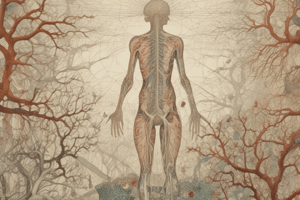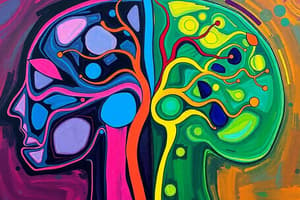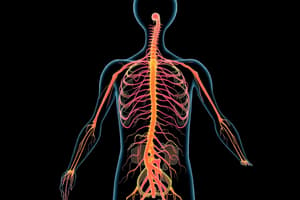Podcast
Questions and Answers
What effect do alpha 1 adrenergic receptors primarily induce in vascular smooth muscle?
What effect do alpha 1 adrenergic receptors primarily induce in vascular smooth muscle?
- Increased heart rate
- Decreased contractility
- Vasoconstriction (correct)
- Vasodilation
Which adrenergic receptor is primarily responsible for increasing heart rate?
Which adrenergic receptor is primarily responsible for increasing heart rate?
- Alpha 2
- Beta 2
- Beta 1 (correct)
- Alpha 1
What is the primary role of beta 2 adrenergic receptors in the lungs?
What is the primary role of beta 2 adrenergic receptors in the lungs?
- Bronchodilation (correct)
- Increased respiratory rate
- Inhibition of norepinephrine release
- Vasoconstriction
What type of drug mimics the action of norepinephrine or epinephrine on adrenergic receptors?
What type of drug mimics the action of norepinephrine or epinephrine on adrenergic receptors?
What effect do alpha 2 adrenergic receptors primarily have when stimulated?
What effect do alpha 2 adrenergic receptors primarily have when stimulated?
Which type of adrenergic receptor is likely involved in lipolysis?
Which type of adrenergic receptor is likely involved in lipolysis?
What physiological response is primarily triggered by the sympathetic nervous system during stress?
What physiological response is primarily triggered by the sympathetic nervous system during stress?
Which receptor type is found in presynaptic nerve terminals and inhibits the release of norepinephrine?
Which receptor type is found in presynaptic nerve terminals and inhibits the release of norepinephrine?
What is the primary function of the autonomic nervous system?
What is the primary function of the autonomic nervous system?
Which division of the autonomic nervous system is responsible for 'rest and digest' functions?
Which division of the autonomic nervous system is responsible for 'rest and digest' functions?
What role do interneurons play in the nervous system?
What role do interneurons play in the nervous system?
What is the function of ganglia in the peripheral nervous system?
What is the function of ganglia in the peripheral nervous system?
Which type of neurotransmitter is primarily involved in activating muscles?
Which type of neurotransmitter is primarily involved in activating muscles?
What distinguishes dorsal root ganglia from autonomic ganglia?
What distinguishes dorsal root ganglia from autonomic ganglia?
What is the role of a presynaptic neuron?
What is the role of a presynaptic neuron?
What is a synapse?
What is a synapse?
What is the primary function of neurotransmitters in the nervous system?
What is the primary function of neurotransmitters in the nervous system?
Which term describes the tiny gap between two neurons?
Which term describes the tiny gap between two neurons?
What role do presynaptic neurons have in neurotransmission?
What role do presynaptic neurons have in neurotransmission?
What distinguishes nicotinic receptors from muscarinic receptors?
What distinguishes nicotinic receptors from muscarinic receptors?
What do postganglionic neurons do in the Peripheral Nervous System?
What do postganglionic neurons do in the Peripheral Nervous System?
Which type of receptor is mainly found in the parasympathetic nervous system?
Which type of receptor is mainly found in the parasympathetic nervous system?
What is a primary use of atropine?
What is a primary use of atropine?
How do G-protein-coupled receptors, such as muscarinic receptors, function?
How do G-protein-coupled receptors, such as muscarinic receptors, function?
What is the mechanism of action of cholinergic antagonists?
What is the mechanism of action of cholinergic antagonists?
Which of the following is a reversible anticholinesterase?
Which of the following is a reversible anticholinesterase?
Which statement about receptor sites in the nervous system is correct?
Which statement about receptor sites in the nervous system is correct?
What is a common adverse effect of neostigmine?
What is a common adverse effect of neostigmine?
What is the primary effect of muscarinic antagonists on the body?
What is the primary effect of muscarinic antagonists on the body?
Which drug is primarily used for treating motion sickness?
Which drug is primarily used for treating motion sickness?
What defines irreversible anticholinesterases?
What defines irreversible anticholinesterases?
Which class of drugs is used to block nicotinic receptors at the neuromuscular junction?
Which class of drugs is used to block nicotinic receptors at the neuromuscular junction?
What is the primary clinical use of pilocarpine?
What is the primary clinical use of pilocarpine?
What adverse effects are associated with pilocarpine due to its ability to enter the brain?
What adverse effects are associated with pilocarpine due to its ability to enter the brain?
Which of the following drugs is NOT an indirect-acting cholinergic agonist?
Which of the following drugs is NOT an indirect-acting cholinergic agonist?
What is the mechanism of action of organophosphates like isoflurophate and echothiophate?
What is the mechanism of action of organophosphates like isoflurophate and echothiophate?
What is the therapeutic use of physostigmine?
What is the therapeutic use of physostigmine?
Why does neostigmine not enter the CNS?
Why does neostigmine not enter the CNS?
What is the primary use of methacholine in clinical practice?
What is the primary use of methacholine in clinical practice?
What adverse effect can result from the excessive stimulation of cholinergic pathways due to organophosphates?
What adverse effect can result from the excessive stimulation of cholinergic pathways due to organophosphates?
Flashcards are hidden until you start studying
Study Notes
Autonomic Nervous System (ANS)
- Regulates involuntary functions such as heartbeat and digestion.
- Composed of three divisions:
- Sympathetic nervous system: Triggers "fight or flight" responses.
- Parasympathetic nervous system: Encourages "rest and digest" activities.
- Enteric nervous system: Manages gastrointestinal functions.
Neurons
- Fundamental units of the nervous system that transmit information.
- Communicate through electrical impulses and chemical signals.
- Types include:
- Sensory neurons: Convey sensory information to the CNS.
- Motor neurons: Relay instructions from the CNS to muscles and glands.
- Interneurons: Connect and facilitate communication within the CNS.
Ganglia
- Clusters of neuron cell bodies located in the PNS.
- Function as relay points for processing and transmitting signals.
- Types include:
- Sensory ganglia: Process sensory signals heading to the CNS.
- Autonomic ganglia: Control involuntary functions including heart rate and digestion.
- Dorsal root ganglia: Contain sensory neuron cell bodies for spinal cord transmission.
Neurotransmitters
- Chemical messengers utilized by neurons for communication.
- Transmit signals across synapses (gaps between neurons).
- Released from presynaptic neurons to bind with receptors on postsynaptic neurons, triggering responses.
Receptor Sites
- Specialized proteins on neuron surfaces responding to neurotransmitters.
- Types of receptors include:
- Cholinergic receptors: React to acetylcholine (ACh).
- Nicotinic receptors: Found in CNS and PNS, open ion channels upon stimulation.
- Muscarinic receptors: Located mainly in parasympathetic system, affect various organs through G-protein-coupled mechanisms.
- Adrenergic receptors: Respond to norepinephrine and epinephrine.
- Alpha (α) receptors:
- α1: Induces vasoconstriction.
- α2: Inhibits norepinephrine release.
- Beta (β) receptors:
- β1: Enhances heart rate and contraction.
- β2: Causes relaxation of bronchial smooth muscle.
- Alpha (α) receptors:
- Cholinergic receptors: React to acetylcholine (ACh).
Sympathetic Nervous System
- Active even at rest but dominant during stress.
- Major adrenergic receptors include α1, α2, β1, and β2.
Sympathomimetics (Adrenergic Agonists)
- Mimic norepinephrine or epinephrine, activating adrenergic receptors.
- Can be categorized as direct-acting, indirect-acting, or mixed-acting.
Cholinergic Agents
- Cholinergic agonists enhance ACh effects, whereas anticholinergics inhibit ACh actions.
- Drug categories include:
- Anticholinergic drugs: Block effects of ACh, used for various conditions like bradycardia and asthma.
- Indirect-acting cholinergic agonists: Inhibit acetylcholinesterase, increasing ACh levels.
Organophosphates
- Irreversible inhibitors of acetylcholinesterase, causing excessive cholinergic stimulation.
- Historically used as nerve agents in warfare; currently used in treating specific eye conditions.
Treatments and Adverse Effects
- Atropine is utilized for organophosphate poisoning and to manage bradycardia.
- Cholinergic agonists can lead to side effects like convulsions and muscle paralysis.
- Neostigmine is used for myasthenia gravis but does not cross the CNS due to its polarity.
Mnemonic for Sympathetic Nervous System
- "A Bee Pounces Dangerously, Be Cautious" aids in recalling adrenergic receptor types and related drugs.
Studying That Suits You
Use AI to generate personalized quizzes and flashcards to suit your learning preferences.



